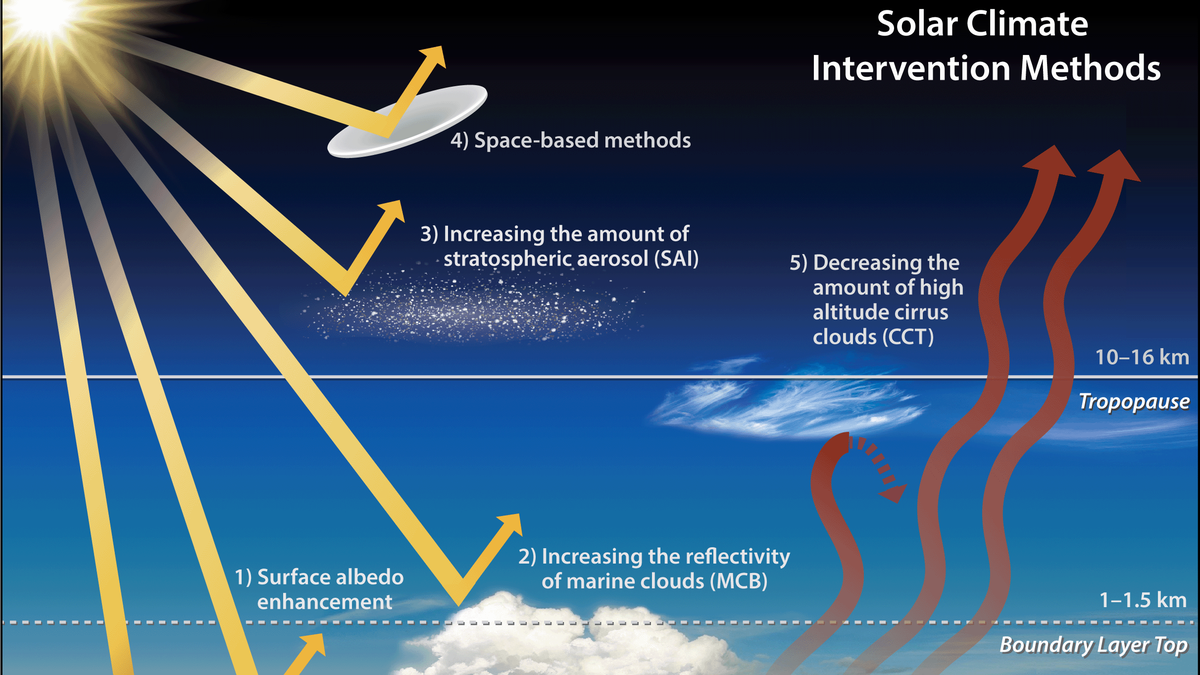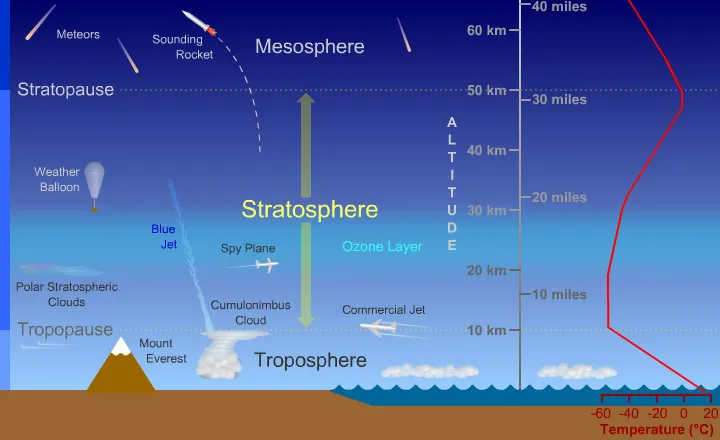Stratospheric Aerosol Injection
New study of Stratospheric Aerosol Injection makes controversial weather-tweaking idea more realistic

Context: As global greenhouse gas emissions continue to rise, researchers are exploring alternative technologies to combat climate change. One such method is Stratospheric Aerosol Injection (SAI) — a controversial yet increasingly studied geoengineering technique.
The Climate Crisis and the Need for Urgent Alternatives
- Global greenhouse gas emissions are increasing, with climate mitigation often sidelined due to war, poverty, disease, and inflation.
- Reducing reliance on fossil fuels is critical, but the pace is slow and uneven.
In this context, researchers are exploring planet-cooling technologies as supplementary tools to fight climate change.
What Are Aerosols?
-
- Aerosols are small particles suspended in the atmosphere.
- They are often not visible or barely visible to the human eye.
- They play significant roles in climate, weather, human health, and ecosystems.
- Size range: From a few nanometers (smaller than viruses) to tens of micrometres (similar to the width of human hair).
- Types of Aerosols:
-
- Primary Aerosols: Directly injected into the atmosphere. Examples include Sea spray, Mineral dust, Smoke (from fires or combustion), and Volcanic ash.
Secondary Aerosols: Formed indirectly from gaseous emissions. Created through chemical reactions in the atmosphere. Common sources include Sulphate aerosols from volcanic eruptions or industrial pollution.
What is SAI?
- Stratospheric Aerosol Injection involves injecting tiny reflective particles (aerosols) into the stratosphere to reduce the amount of sunlight reaching the Earth’s surface.
- This technique aims to cool the planet, mimicking the natural cooling effect observed after volcanic eruptions.
- Inspiration from Volcanic Activity: Volcanic eruptions, such as Mount Pinatubo in 1991, released millions of tonnes of aerosols into the atmosphere, cooling the planet by about 0.5°C for over a year. SAI is based on replicating this natural cooling mechanism using sulphur dioxide aerosols.

Current Technical Challenges
- A key factor in the success of SAI is the altitude, location, and timing of aerosol injection. Most SAI proposals focus on injection 20 km or more above Earth, especially in equatorial regions, where the stratosphere is higher.
- Existing aircraft cannot fly at such high altitudes, necessitating the development of specialised aircraft, which can take up to a decade and require billions of dollars.
A New, Cost-Effective Approach
-
- A recent study published in Earth’s Future, led by Alistair Duffey (UCL), explores the use of existing aircraft to perform SAI at lower altitudes in polar and extratropical regions.
- In these regions, the tropopause (boundary between troposphere and stratosphere) lies at lower altitudes, making the stratosphere more accessible.
- Study Findings:
-
- Researchers used the UK Earth System Model 1 (UKESM1) to simulate different injection strategies.
- Injecting 12 million tonnes of sulphur dioxide per year at 13 km altitude during local spring and summer in each hemisphere could cool the planet by approximately 0.6º C.
- For 1º C of cooling, 21 million tonnes per year would be required.
- In contrast, if injection occurs at higher altitudes in the subtropics, only 7.6 million tonnes annually are needed for the same effect.
Advantages of the New Method
- Cost-effective and faster to implement by using modified existing aircraft like the Boeing 777F.
- Modifications include insulated, double-walled pressurised tanks to safely transport and manage aerosols during flight.
- Could begin much sooner than high-altitude alternatives that rely on specialised aircraft.
Risks and Controversies
- Despite its promise, SAI is fraught with risks. Deploying three times the usual amount of aerosols (as required in lower-altitude scenarios) could amplify negative side effects, such as:
- Delayed recovery of the ozone layer
- Acid rain
- Ecological disruptions
- Uneven regional impacts — with stronger cooling in polar areas, while tropical regions, where warming is more severe, may benefit less
- Moreover, SAI does not reverse climate change or address root causes like emissions and ecosystem degradation. It only temporarily masks surface warming, which could lead governments to become complacent about cutting emissions.
- Social, political, and geopolitical implications are even more contentious. Since the effects of SAI are global, the decision of a single country to proceed could affect the entire planet — potentially triggering diplomatic disputes or unintended climate consequences elsewhere.
The Governance Challenge and Way Forward
- In 2021, the US National Academies recommended solar geoengineering research with transparency. In 2022, an international coalition called for a moratorium on such research, citing it as “ungovernable in a fair, democratic, and effective manner.”
- Duffey acknowledges that current findings are limited due to the number of simulations. A more comprehensive follow-up study is underway.
- While promising for early, cost-effective deployment, low-altitude SAI is not a substitute for emission reductions — merely a possible temporary mitigation tool.
Subscribe to our Youtube Channel for more Valuable Content – TheStudyias
Download the App to Subscribe to our Courses – Thestudyias
The Source’s Authority and Ownership of the Article is Claimed By THE STUDY IAS BY MANIKANT SINGH





